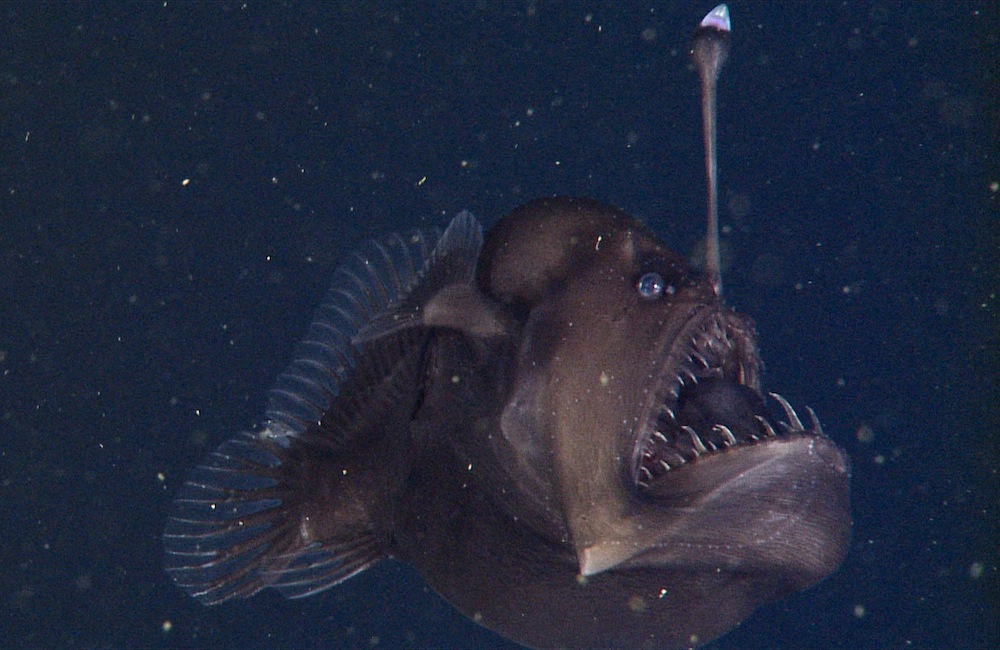Animal Sex: How Anglerfish Do It

People may have gotten their first glimpse of an anglerfish in the 2003 animated movie "Finding Nemo," where this fish's frightening mug — including a luminescent lure sprouting from the top of its head, and a gaping mouth full of large, spiky teeth — looms menacingly over the tiny hero. But the mating behaviors of the deep-sea-dwelling anglerfish, as well as their odd penchant for sexual parasitism, may make them more fit for a horror movie than a kids' movie.
All anglerfish belong to the group of fish called the Lophiiformes order, but the most unusual anglerfish are those of the suborder Ceratioidei, which consists of 160 recognized species. These fish can be found throughout the world's oceans at depths below 984 feet (300 meters).
Unlike other anglerfish, ceratioid anglerfish show extreme sexual dimorphism — that is, females are much larger than males. In fact, males of the anglerfish species Photocorynus spiniceps compete for the title of the world's smallest vertebrate. And in the species Ceratias holboelli females may be more than 60 times longer and half a million times heavier than males, according to anglerfish expert Ted Pietsch, curator of fishes at the Burke Museum at the University of Washington.
Both males and females go through metamorphosis as they develop into adults, Pietsch said. Females gain the large teeth and fleshy lure the fish are known for, while males often grow large, well-developed eyes and big nostrils. Males also lose their normal teeth and grow a set of pincerlike "denticles," which are toothlike projections that sit at the front tips of their jaws, and as it turns out, are absolutely necessary for mating.
Males spend their lives looking for females, according to Pietsch. In some species, the males' highly tuned sense of smell helps them zero in on female pheromones. Other males have underdeveloped nostrils, and instead rely on their excellent vision to find the glowing lures of females.
Once a male finds a female, he uses his denticles to latch onto her, typically in her belly region, while he's upside down. Then, the tissues of the male and female will fuse, and the pair's circulatory systems will even connect, though it's unknown how this happens.
"The exact nature of tissue fusion has never been studied because of the impossibility (so far) of maintaining specimens alive," Pietsch told Live Science.
Sign up for the Live Science daily newsletter now
Get the world’s most fascinating discoveries delivered straight to your inbox.
After fusing, "the male becomes permanently dependent on the female for blood-transported nutrients, while the host female becomes a kind of self-fertilizing hermaphrodite," Pietsch wrote in his review of ceratioid anglerfish, published in 2005 in the journal Ichthyological Research. Onceattached, males also grow substantially, becoming much larger than any free-swimming male ceratioid anglerfish. They remain alive and able to reproduce as long as their mates live.
Unlike with many other animals, female ceratioids have "no choice whatsoever" in their mates, Pietsch said. And in some anglerfish, such as Cryptopsaras, females may even become basically a host for many males — sometimes carrying up to eight parasitic mates.
When the female is ready to reproduce, fertilization takes place externally, with the mates releasing their sperm and eggs into the water at the same time. This is true even for females with multiple male mates. The synchrony of this sperm and egg release is likely arranged through hormonal communication, Pietsch said.
Interestingly, some ceratioids have a trait that scientists call "obligatory parasitism," meaning that the fish don't become sexually mature until they're fused with a mate. What's more, a male will die if he doesn't find a female within the first few months of his life.
Many other ceratioid anglerfish are nonparasitic — a male will latch onto the female, release his sperm while she releases her eggs and then swim off. In these cases, the pair's tissues never fuse.
Follow Joseph Castro on Twitter. Follow us @livescience, Facebook & Google+. Original article on Live Science.











